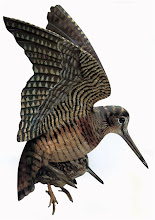 We have been tracking woodcocks via satellite with PTTs developed by Microwave Telemetry Inc (MTI) since 2006.
We have been tracking woodcocks via satellite with PTTs developed by Microwave Telemetry Inc (MTI) since 2006.The first two projects fixed the beginning of a new era in the knowledge of that migration. It was the first time that such experiments were made in Europe with this kind of birds, due to their small weight and their very special behavior.
“(a) What is the accuracy of Doppler locations?
Location accuracy varies with the geometrical conditions of the satellite passes [4], the stability of the transmitter oscillator, the number of messages collected and their distribution in the pass. This means in particular that a given transmitter can have locations distributed over several classes during its lifetime.
Classes for which accuracy is estimated and related values:
- Class 2: better than 350 m, 500 m radius
- Class 1: better than 1000 m, 1500 m radius
- Class 0: over 1000 m, over 1500 m radius
- Class 1: better than 1000 m, 1500 m radius
Assuming as on March 5th that we have a LC 2 location followed by a LC B location, in a very short period of time when the bird is supposed not to move, the accuracy of LC B location is, more or less:
(2) For Navarre, ID 73388, the LC A locations, in the studied cases, have an error between 5.46 and 9.37 km [8].
(3) For Navarre, ID 73388, the LC B locations, in the studies cases, have an error between 1.10 and 10.82 Km.
Kaatz, M. (2004) Mit Prinzesschen unterwegs, 25 Jahre Storchenhof Loburg, 25 Jahre NABU-Bundesarbeitsgruppe Weißstorchschutz. Thesis’ title: Der Zug des Weißstorchs Ciconia ciconia auf der europäischen Ostroute über den Nahen Osten nach Afrika.
For more information, see http://es.scribd.com/doc/58456473/Accuracy-of-A-and-B-class-locations.
[2] See Location accuracy of emissions gathered via satellite: http://www.euskonews.com/0484zbk/gaia48404en.html.(Christian Ortega from Argos wrote us to take into account the GDOP phenomenon and the fact that the accuracies given by Argos are inside ellipses.)
[3] See http://www.argos-system.org/html/system/faq_en.html and http://www.clsamerica.com/argos-system/faq.html.
[4] The so-called GDOP, Geometric Dilution of Precision, is a measure of the effect of the geometry of the satellite-beacon configuration on location accuracy. The actual Argos location accuracy depends on both the GDOP value and the quality of the transmitter (frequency stability). As a general rule, a smaller GDOP value yields a more accurate position. See http://www.sevin.ru/seminary/argos/Argos%20location.pdf.
[5] The errors 150m/ 350 m/ 1000m are in each axis of the ellipse. The radius of the circle of error is greater.
[6] In 2006, we had no possibility to make this kind of calculus. The periods of time between the different emissions given in the same day were not short at all. (About our different projects, see Scolopax rusticola without frontiers: http://www.euskonews.com/0522zbk/gaia52202en.html.
[7] One should take into account what Kaatz says in his thesis about class 1 locations. Michael Kaatz (2004) has taken into account the real positions following the storks and the positions given by Argos. When dealing with the accuracy of the emissions, Kaatz underlines the following: Using the 68th percentile to define the accuracy of locations estimates, observed accuracy was 3.19 km for location class (LC) 1. With more percentile the accuracy is even less. According to Kaatz, the accuracy depends on the radiated power and on oscillators: lower oscillators minimize the frequency drift.
[8] We have taken into account Kaatz’s thesis.
[9] As to the accuracy of class A and B locations, here what can be read in Hays et al. (2001): “In our trials the accuracy of LC A was comparable to that of LC 1. LC B had poorer accuracy than LC A, but the worst level of accuracy was found in LC 0.”
According to C. Vincent et al. (2002), "Both filtered and unfiltered LC A locations were of a similar accuracy to LC 1 locations, and considerably better than LC 0 locations."
[10] See Scolopax rusticola without frontiers: http://www.euskonews.com/0522zbk/gaia52202en.html..
[11] See what is said in note 8.


.bmp)
.bmp)
.bmp)
+19,000+km.bmp)















